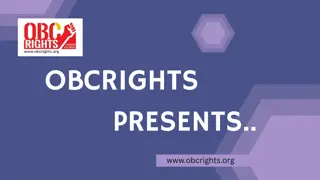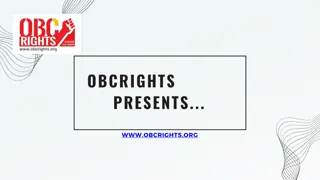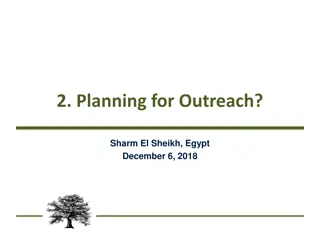Enhancing Scholarship Through Teaching and Outreach Portfolios
Explore the impact of using teaching and outreach portfolios to document scholarly contributions at the University of Arizona. Discover the inclusive view of scholarship, peer review processes, interpreting course evaluations, and strategies for documenting outreach and service. Learn from presenters about innovative approaches to scholarship and the importance of various forms of engagement in academia.
Download Presentation

Please find below an Image/Link to download the presentation.
The content on the website is provided AS IS for your information and personal use only. It may not be sold, licensed, or shared on other websites without obtaining consent from the author.If you encounter any issues during the download, it is possible that the publisher has removed the file from their server.
You are allowed to download the files provided on this website for personal or commercial use, subject to the condition that they are used lawfully. All files are the property of their respective owners.
The content on the website is provided AS IS for your information and personal use only. It may not be sold, licensed, or shared on other websites without obtaining consent from the author.
E N D
Presentation Transcript
USING TEACHING AND OUTREACH PORTFOLIOS TO DOCUMENT IMPACT Monday, April 23, 2018
OUR AGENDA The University of Arizona s inclusive view of scholarship Peer reviews and evaluation of teaching portfolios Interpreting teacher course evaluations (TCEs) Documenting outreach and service Wrap-up and discussion
TODAYS PRESENTERS Ingrid Novodvorsky, Office of Instruction & Assessment Rebecca Perez, Office of Instruction & Assessment Dan McDonald, Norton School for Family and Consumer Sciences Tannis Gibson, Fred Fox School of Music
OUR INCLUSIVE VIEW OF SCHOLARSHIP The University values an inclusive view of scholarship in the recognition that knowledge is acquired and advanced through discovery, integration, application, and teaching. Given this perspective, promotion and tenure reviews, as detailed in the criteria of individual departments and colleges, will recognize original research contributions in peer-reviewed publications as well as integrative and applied forms of scholarship that involve cross-cutting collaborations with business and community partners, including translational research, commercialization activities, and patents.
Ernest Boyers Scholarship Reconsidered: The scholarship of discovery includes investigations inquiries that generate new knowledge. The scholarship of integration makes interdisciplinary connections to synthesize knowledge in new ways. The scholarship of application is concerned with applying knowledge to social issues, sometimes to test theories and ground knowledge making. The scholarship of teaching includes transforming and extending as well as transmitting knowledge. The scholarship of engagement extends these forms of inquiry by collaborative inquiries on social issues. Based on The Scholarship of Engagement, Center for Experiential Learning, Loyola University
From The Scholarship of Engagement, Center for Experiential Learning, Loyola University, Chicago
The Scholarship of Teaching & Learning at UA Home Office of Instruction & Assessment Building capacity for excellent teaching Faculty Learning Communities Collaborative Learning Spaces Peer Review of Teaching Protocol CUES SEMINAR SERIES DISTINGUISHED FELLOWSHIPS SYMPOSIA AND WORKSHOPS TEACHING SCHOLAR CIRCLES
AN INCLUSIVE VIEW OF SCHOLARSHIP Develop an outcomes assessment plan to identify metrics that demonstrate your impact. Consider benchmarks for the advancement of your teaching and outreach. Use your Candidate Statement to frame your program of work with an inclusive vision. Document your leadership and impact in Sections 6, 7, and 8 of your dossier. Identify collaborators for your committee chair and/or head to solicit letters to offer testimony to your effective collaborators.
PEER REVIEW PROTOCOL & CRITERIA FOR EVALUATING TEACHING PORTFOLIOS Ingrid Novodvorsky Director, Teaching, Learning, & Assessment Office of Instruction & Assessment
PEER REVIEW PROTOCOL Section 7: Evaluation of Teaching & Teaching Portfolio Classroom Observation Reports On letterhead, dated, and signed by reviewer(s) OIA Resource: Peer Review of Teaching Protocol
EVALUATING TEACHING PORTFOLIOS Section 7: Evaluation of Teaching & Teaching Portfolio Departmental Review Assessment of Teaching Portfolio
EVALUATING TEACHING PORTFOLIOS Criteria for Evaluation of Teaching Portfolios Overall Content Teaching Philosophy Student Learning Outcomes Active Learning Strategies Student Assessment Professional Development
INTERPRETING TEACHER COURSE EVALUATIONS Rebecca Perez Assistant Director, Instructional Data Office of Instruction & Assessment
TCE CONSULTATION AND SUPPORT SERVICES Assistance accessing TCE reports Consultation with departments or committees on adding questions for comprehensive performance appraisal planning An additional 7 instructor/department questions may be added
TCE CONSULTATION AND SUPPORT SERVICES Assistance to faculty accessing and interpreting TCEs Adding additional questions targeting specific teaching elements Contact Rebecca P rez, Assistant Director, Instructional Data Office of Instruction and Assessment rperez@email.arizona.edu and 626-0536
TCEs: ONLY ONE SOURCE OF STUDENT INPUT Instructor and course TCE core questions on teaching effectiveness provide comparisons of the instructor/course with appropriate comparison groups Can be used to show trends over time TCE and OIA provide consultation on interpreting and improving teaching effectiveness using TCE scales
TCEs: ONLY ONE SOURCE OF STUDENT INPUT TCEs can provide student feedback to help assess a variety of teaching models, such as online classes, teams, TA s, 7.5-week courses, and dynamically dated classes The availability of TCE results to UA students and faculty by course and instructor increases accountability for effective teaching
CORE QUESTIONS The 11 core questions are: 1. What is your overall rating of this instructor s teaching effectiveness? 2. What is your rating of this instructor compared with other instructors you have had? 3. What is your overall rating of this course? 4. I was treated with respect in this class 5. Rate the overall usefulness of in-class meeting time activities (e.g., lectures, discussions, teamwork, labs) in helping you achieve important course goals and objectives 6. Rate the overall usefulness of outside (not in class) assignments (homework, papers, reports, social projects, online work) in helping you achieve important course goals and objectives
CORE QUESTIONS The 11 core questions are: 7. Rate the overall usefulness of assigned texts and readings (print or online) in helping you achieve important course goals and objectives 8. Rate the overall usefulness of online instructional tools and technology in this course (e.g., D2L, Blackboard, Panopto, Moodle, custom course websites and tools) in helping you achieve important course goals and objectives 9. How difficult was this course for you? 10.How much do you feel you have learned in this course? 11.Of the total hours you spent in this class, how many were valuable in advancing your education?
CORE QUESTIONS There are also two comment questions: What did you especially like about this course? (open text box) What suggestions would you make to improve this course? (open text box)
TCE STANDARD REPORT Includes all statistical information for all questions Provides response counts, means and standard deviations Comments are available as a separate report
TCE COMPARISON GROUPS Department class sections history Lower division, upper division Class size Type: lecture, seminar, colloquium Fall/spring semesters
COMPARISON REPORT Core items Response distribution frequency and percentages Item mean, standard deviation, 95% confidence interval Comparison groups: mean, standard deviation, 95% confidence interval How-to-Guide (tce.arizona.edu/content/reports)
DOCUMENTING AND ASSESSING OUTREACH AND SERVICE Dan McDonald Interim Director, Norton School of Family and Consumer Sciences
EXAMPLES OF SERVICE ACTIVITIES Examples of activities for service with sources of evaluation input https://cals.arizona.edu/about/workplace/promotion/guidelines- criteria/appendixa To be used in conjunction with the position description in evaluating CALS faculty for promotion and/or tenure/continuing status Faculty service Professional service Public or Community service/outreach
EVALUATING FACULTY SERVICE Serving on unit, college, and/or university committees Serving in Faculty Senate Chairing any committee (student, faculty, etc.) Serving as a sponsor for student activities and groups, or volunteer organizations Administrative assignments Mentoring other faculty
EVALUATING PROFESSIONAL SERVICE Activity in professional organizations Consulting to organizations/corporations Consulting to universities and colleges Editing of journals Organizing conferences or symposia Serving on committees for federal or state government agencies or on boards
EVALUATING PUBLIC OR COMMUNITY SERVICE/OUTREACH Participating in local, state, or national civic activities and organizations Applying one s academic expertise in the local, state, or national community Working with elected officials
SOURCES OF EVALUATION INPUT Faculty review committees External peer reviews Self-evaluation Unit head assessment Administrative supervisor Faculty and staff colleagues Awards and recognition Statewide clientele, including public agencies, grower groups, etc.
FOR FURTHER INFORMATION https://facultyaffairs.arizona.edu/co ntent/about-promotion























